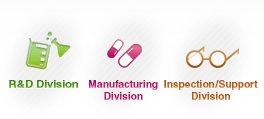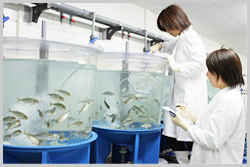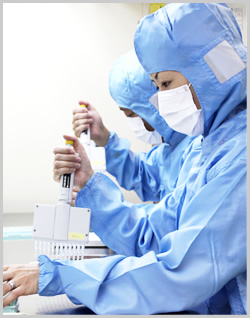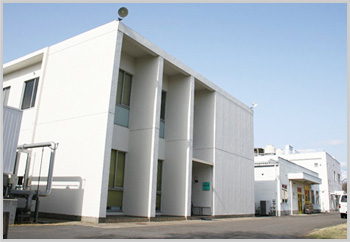HOME > R&D, Production > Advanced Technology Development Center / Tsukuba Plant > Department
R&D, Production
 Advanced Technology Development Center / Tsukuba Plant
Advanced Technology Development Center / Tsukuba Plant
The Advanced Technology Development Center/Tsukuba Plant aims to contribute to society by developing and supplying high quality products that help create a safe and comfortable environment for both humans and animals. The Center is comprised of three functional divisions (R&D Division, Manufacturing Division, and Inspection/Support Division) which cooperate with each other in order to fulfill this role.

R&D Division

Research and development starts with gathering market information and epidemiological surveys.
The main factors we take into consideration are what market needs exist, whether these needs are epidemiologically important, and whether we can develop a suitable formulation using our current technological capabilities.
If formulation is possible, development must be conducted quickly
After completing a range of laboratory testing, including experiments to determine physical, chemical, and biological properties as well as safety, efficacy, and stability, development moves to the clinical trial stage. Once clinical trials have been completed the findings must be summarized and an application for manufacture and sales approval submitted to the Ministry of Agriculture, Forestry and Fisheries, the regulatory agency responsible for overseeing animal health care products in Japan. A number of check gates (pharmaceutical affairs council review) must be passed before approval is granted, and the R&D Division is responsible for handling the relevant preparations.
The R&D Division is responsible for coordinating the many operations required from the time of approval through to release to market.
This includes determining package design, planning product briefing sessions, drafting technical materials – and more. Transferring technical expertise from the development stage to the manufacturing process is also critical.
Process development is the key to resolving technical challenges in large-scale manufacturing. Once process development is complete, the technology is transferred to the Manufacturing Division as a routine production system.
Further studies are required after releasing a product to market, including re-examination and re-evaluation.
In the case of new medicines, the initial approval is essentially a "provisional license." Only after proving a medication's effectiveness by gathering data regarding safety, efficacy, and other factors during the designated time period is a "full license" granted. This is the re-examination system.
Technology advances rapidly, and products sometimes need to be re-evaluated in light of new findings. Any necessary re-examinations or re-evaluations following product release are handled by the R&D Division.
Manufacturing Division

The Manufacturing Division is responsible for manufacturing vaccines, diagnostics, and non-prescription medicines, as well as conducting quality control to ensure the stable supply of high quality products.
The Tsukuba Plant manufactures vaccines and diagnostics.
The Manufacturing Division's mission is to deliver products of uniform high quality in line with Good Manufacturing Practices (GMP). However, manufacturing products efficiently and methodically while maintaining sound quality control is no easy task.
In order to maintain uniform quality, any slight changes in condition must be detected and resolved immediately. This requires a keen "sense" for manufacturing.
The Manufacturing Division has a major responsibility not only for ensuring that routine manufacturing and quality control processes run smoothly, but also improving existing formulations. Accordingly, the Division concurrently works to implement a range of improvements with the aim of achieving a high quality, low cost product supply. If these improvements require approval, the Division submits a supplemental new drug application for official authorization.
The same procedures for approval are needed as in the case of new drugs.
Inspection and Support Division

"People, goods, money, and information" are the key elements that allow an organization to function-and the Advanced Technology Development Center/Tsukuba Plant is no exception. Goods are produced by the R&D Division and the Manufacturing Division. Meanwhile, the Inspection and Support Division supports both of the aforementioned divisions by providing people, money, and information.
The majority of the operations performed at the Center are regulated by Japan's Pharmaceuticals and Medical Devices Act. Accordingly, the Center includes an Inspection division responsible for ensuring that the company's operations meet all required laws and regulations, as well as a division tasked with providing human resources, labor, accounting, and IT support across the organization. The site also maintains a division that specializes in the performance of pathologic examinations, as well as a division tasked with performing a range of tests for marketing and promotion purposes.
